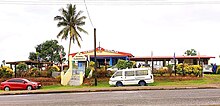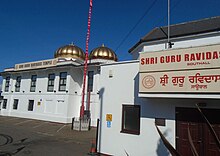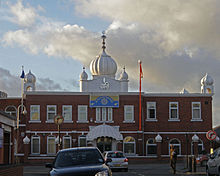Ramdasia
Terminology
Ramdasia is a term used in general for Sikhs whose ancestors belonged to Chamar caste. Originally they are followers of Guru Ravidass who belongs to Chamar community. Both the words Ramdasia and Ravidasia are also used inter changeably while these also have regional context. In Puadh and Malwa, largely Ramdasia is used while Ravidasia is predominantly used in Doaba.

Ramdasia Sikhs are enlisted as scheduled caste by Department of Social justice, Empowerment and Minorities- Government of Punjab. On Department's list of Scheduled Caste, this caste is listed on serial number 9 along with other Chamar caste synonymous such as Ravidasia, Jatav and so on.
Military service
British Raj

During World War I the single-battalion regiments of the Mazhabi and Ramdasia Sikh Pioneers – the 23rd, 32nd and 34th Pioneer Regiments – were expanded to comprise three battalions each. These units served in Egypt, Europe, Mesopotamia and Palestine and performed well. The 1/34th Sikh Pioneers were awarded the title of "Royal".
The Ramdasia Sikhs, together with the Majhabi Sikhs, were recruited to the Sikh Light Infantry regiment (SLI) after its formation in 1941. The Sikh Light Infantry has always been a "single class" regiment in the parlance adopted from the British Raj era. This means that it recruits only from one demographic, which in this instance means the Ramdasia Sikhs and Mazhabi Sikhs. Indeed, the SLI was initially called the Mazhabi & Ramdasia Sikh Regiment. Despite unwillingness among some policy makers, the British had to abandon their traditional distinction between martial and non-martial races during the Second World War. This was necessitated by the need for more recruits than could be supplied by those communities upon which they usually relied, such as the Jat Sikhs, Dogras and Punjabi Musalmans. In addition, indiscipline among Jat Sikhs caused by their concerns regarding a post-war division of India was another reason to prefer recruitment of new classes. While recruitment from the pre-war martial classes was still pre-eminent, that from newly recognised classes such as the Ramdasias and Mazhabis became significant.
After independence of India
When India became independent in 1947, the British Indian Army became the Indian Army. This, like its predecessor, relies on the martial race theory for much of its recruitment and thus there is a grossly disproportionate number of Sikhs within its ranks. The Ramdasias Sikhs and Mazhabi Sikhs continued their service with the SLI in the new army. The SLI has served in almost all of the post-1947 conflicts involving India, including the wars with Pakistan in 1947, 1965 and 1971, the Hyderabad Police Action of 1948 and the Chinese aggression in 1962. It has also served in Sri Lanka, where the 1st, 7th, 13th and 14th Battalions have contributed towards peace-keeping.
Hindu Ramdasia
This sect of Ramdasia having faith in Hinduism and they mostly residing in Pathankot, Jammu, Himachal Pradesh and Jalandhar. Hindu Ramdasia migrated from Pakistan and back in Sialkot, these Ramdasia were involved in Leather/Sports Goods Business. After migrating in Jalandhar they established their own Tanneries and Sports Goods manufacturing Units. For This purpose Government of Punjab, India helped them by providing liberal loans and allotting sites for their Factories Hindu Ramdasia's are staunch follower of Guru Ravidass and they follow Dera Swami Gurdeep Giri ji, Pathankot. According to Department of Social Justice and Empowerment, Government of India Ramdasias are listed as Chamar Caste on serial number 4 and 14 for Jammu and Kashmir and Himachal Pradesh respectively.



Demographics
As of 2011 Census, there were 3,095,324 Chamars in the Indian state of Punjab, of whom 1,017,192 declared themselves as Ad-Dharmi Chamar and 2,078,132 declared themselves as Ramdasia/Ravidasia Chamar. According to this Census, during the same year the population of Sikh Ramdasia/Ravidasia and Hindu Ramdasia/Ravidasia in Punjab was 1,443,079 and 629,157 respectively.
Most of the Hindu Ramdasias (Counted along with other Chamar Caste Synonyms such as Ravidasia and Jatav) living in the Jammu and Kashmir, Himachal Pradesh and Haryana. As of 2011, there were 212,032 Ramdasia in Jammu and Kashmir, comprising 209,512 Hindus, 2,486 Sikhs and 34 Buddhists, 2,429,137 lived in Haryana (2,390,403 Hindu, 37,191 Sikh and 1,543 Buddhists) and 458,838 resided in Himachal Pradesh (453,871 Hindu, 4,887 Sikh and 80 Buddhists)
Ramdasia Diaspora and Guru Ravidass Temples and Gurdwaras
Ramdasia Sikh diaspora alongside Ravidassia from doaba emigrated from India and Pakistan is significant. Emigration from the Punjab began before and after the 19th century, with many Ravidasia/Ramdasia Sikhs settling in Europe, and also a large Ravidasia/Ramdasia Sikhs population in North America mainly in United States and the Canada. There is sizeable population of Ravidasia/Ramdasia Sikhs in Oceania as well.




Fiji
- Guru Ravidass Gurdwara (Nasinu Sikh Temple), Nasinu (Established in 1939)
New Zealand
- Guru Ravidass Sikh Temple, Bombay Hills, Auckland (Established in 1991)
- Guru Ravidas Temple, Hastings (Established in 2007)
- Gurdwara Begampura Sikh Temple, Papakura (Established in 2008)
Australia
- Guru Ravidas Gurdwara, Campbellfield, Melbourne (Established in 1996)
England
- Shri Guru Ravidas Bhavan, Birmingham
- Shri Guru Ravidass Temple, Southall
- Shri Guru Ravidass Community Centre, Handsworth
- Shri Guru Ravidass Temple, Wolverhampton
- Shri Guru Ravidass Community Centre, Wolverhampton
- Shri Guru Ravidas Temple - Coventry
- Shri Guru Ravidass Community Centre, Coventry
- Shri Guru Ravidass Temple, Hockley
- Shri Guru Ravidas Temple - Foleshill
- Shri Guru Ravidass Temple, Rebecca Street, Bradford
- Gurdwara Shri Guru Ravidass Maharaj Ji, Thornbury Street, Bradford
- Shri Guru Ravidass Gurdwara - Bedford
- Shri Guru Ravidass Temple - Darlaston
- Guru Ravidass Sabha Community Centre, Derby
- Shri Guru Ravidass Sikh Temple - Derby
- Shri Guru Ravidass Sikh Temple, Leicester
- Shri Guru Ravidass Temple - Willenhall
- Shri Guru Ravidass Temple - Walsall
- Shri Guru Ravidass Gurdwara - Erith Kent
- Shri Guru Ravidass Gurdwara and Community Centre- Hitchin
- Shri Guru Ravidass Gurdwara- Newham, London
- Guru Ravidass Sabha, Northampton
- Dera Baba Gobind Dass, Guru Ravidass Sabha, Bilston
- Shri Guru Ravidass Gurdwara - Gravesend
- Shri Guru Ravi Dass Sabha - Letchworth
- Shri Guru Ravidass Bhavan - Luton
- Shri Guru Ravidass Gurdwara- Strood, Medway
- Shri Guru Ravidass Gurdwara - Southampton
- Shri Guru Ravidass Temple, Glasgow
- Shri Guru Ravidass Mission Temple, London
United States
- Guru Ravidass Sikh Temple, Pittsburg, California
- Guru Ravidass Sikh Temple, Fresno
- Guru Ravidass Sikh Temple, Rio linda
- Guru Ravidass Sikh Temple, Union City
- Guru Ravidass Sikh Temple, Yuba City
- Guru Ravidass Gurdwara, Selma
- Guru Ravidass Sikh Temple, Houston
- Guru Ravidass Sikh Temple, New York
- Guru Ravidass Sabha, DFW, Texas
Canada
- Guru Ravidass Gurdwara, Burlington
- Guru Ravidass Sabha, Brampton
- Guru Ravidas Temple, Ariss, Toronto
- Guru Ravidass Sikh Temple, Montreal
- Guru Ravidass Sabha, Edmonton
- Guru Ravidass Sikh Temple, Vancouver
- Guru Ravidass Gurdwara and Community Centre, Calgary
See also
References
- ^ Chander, Rajesh K I. (2019). Combating Social Exclusion: Intersectionalities of Caste, Class, Gender and Regions. Studera Press. p. 64. ISBN 978-93-85883-58-3.
- ^ Ghuman, Paul (May 2011). British Untouchables A Study of Dalit Identity and Education. Ashgate Publishing, Limited. p. iX. ISBN 978-0754648772.
- ^ "Punjab's dalit conundrum: A look into Sikhs' caste identity". The Times of India. 30 September 2021. Retrieved 11 October 2021.
- ^ http://socialjustice.gov.in/writereaddata/UploadFile/Scan-0015.jpg
- ^ "History". 2009-04-15. Archived from the original on 2009-04-15. Retrieved 2022-08-03.
- ^ Wilkinson, Steven I. (2015). Army and Nation: The Military and Indian Democracy Since Independence. Harvard University Press. p. 11. ISBN 978-0-67472-880-6.
- ^ Wilkinson, Steven I. (2015). Army and Nation: The Military and Indian Democracy Since Independence. Harvard University Press. pp. 39–41. ISBN 978-0-67472-880-6.
- ^ Cohen, Stephen (2013). "The Untouchable Soldier". In Karsten, Peter (ed.). Recruiting, Drafting, and Enlisting: Two Sides of the Raising of Military Forces. Routledge. p. 170. ISBN 978-1-13566-150-2.
- ^ Marston, Daniel (2003). Phoenix from the Ashes: The Indian Army in the Burma Campaign. Greenwood Publishing Group. pp. 218–220, 236. ISBN 978-0-27598-003-0.
- ^ Roy, Kaushik (2015). "Indian Society and the Soldier". In Pant, Harsh V. (ed.). Handbook of Indian Defence Policy: Themes, Structures and Doctrines. Routledge. pp. 66–67. ISBN 978-1-31738-009-2.
- ^ "Story of The Sikh Light Infantry". The Sikh Review. Archived from the original on 2002-05-31.
- ^ Sharma, Krishan L. (1980). Entrepreneurial Growth and Development Programmes in Northern India. Abhinav Publications. p. 67. ISBN 9780836406498.
- ^ http://socialjustice.gov.in/writereaddata/UploadFile/Scan-0006.jpg
- ^ http://socialjustice.gov.in/writereaddata/UploadFile/Scan-0030.jpg
- ^ "SC-14 Scheduled Caste Population By Religious Community (States/UTs) – Punjab" (XLS). The Registrar General & Census Commissioner, India. Retrieved 2021-06-27.
- ^ "SC-14 Scheduled Caste Population By Religious Community (States/UTs) – Jammu and Kashmir" (XLS). The Registrar General & Census Commissioner, India. Retrieved 2021-06-27.
- ^ "SC-14 Scheduled Caste Population By Religious Community (States/UTs) – Haryana" (XLS). The Registrar General & Census Commissioner, India. Retrieved 2021-06-27.
- ^ "SC-14 Scheduled Caste Population By Religious Community (States/UTs) – Himachal Pradesh" (XLS). The Registrar General & Census Commissioner, India. Retrieved 2021-06-27.
- ^ British Untouchables: A Study of Dalit Identity and Education. Ashgate Publishing. 2011. ISBN 9780754689683.
- ^ Sikhs in Europe: Migration, Identities and Representations. Routledge. April 2016. ISBN 9781317055051.
- ^ https://ambedkartimes.com/AT-25-June%2028,%202023.pdf
- ^ McLeod, W. H. (1986). "Punjabis in New Zealand: A History of Punjabi Migration, 1890-1940".
- ^ "Guru Ravidass Gurudwara - Nasinu - World Gurudwaras".
- ^ "About".
- ^ "Gold dome from India completes Hastings Ravidass temple". 8 October 2023.
- ^ "Shri Begampura Gurdwara Sahib".
- ^ "Gurudwaras in Melbourne".
- ^ "Shri Guru Ravidass Bhawan Website". Archived from the original on 2023-01-29. Retrieved 2024-06-11.
- ^ "Shri Guru Ravi Dass Sabha Temple". sgrds.org. Retrieved 2024-06-11.
- ^ "Handsworth Wood Girls School to be turned into community centre". 5 May 2010.
- ^ "Sikh temple to be demolished to make way for a replacement". BBC News. 6 August 2023.
- ^ "Guru Ravidass Ji Temple Wolverhampton, UK | Guru Ravidass Ji Temple Wolverhampton, UK". Retrieved 2024-06-11.
- ^ "Shri Guru Ravidass Sabha Temple - Faith groups". Coventry City Council. Retrieved 28 April 2024.
- ^ "Ravidassia Community Centre". Coventry City of Peace. 3 August 2019. Retrieved 28 April 2024.
- ^ "AMRIT BANI RAVIDASSIA COMMUNITY CENTRE LTD people - Find and update company information - GOV.UK". find-and-update.company-information.service.gov.uk. Retrieved 28 April 2024.
- ^ "Shri Guru Ravidass Temple (Foleshill)". Retrieved 28 April 2024.
- ^ "SHRI GURU RAVIDASS SABHA, BRADFORD - Charity 517411". register-of-charities.charitycommission.gov.uk. Retrieved 28 April 2024.
- ^ "Other Bradford Gurdwaras". Guru Gobind Singh Gurdwara. Retrieved 1 May 2024.
- ^ "Home | Sri Guru Ravidass Sabha-Bedford". www.gururavidasssabhabedford.com. Retrieved 28 April 2024.
- ^ "SHRI GURU RAVIDASS CULTURAL ASSOCIATION DARLASTON - Charity 514570". register-of-charities.charitycommission.gov.uk.
- ^ "Guru Ravidass Community Centre on Community Directory Derbyshire". www.communitydirectoryderbyshire.org.uk.
- ^ "Shri Guru Ravidass Sabha Derby - World Gurudwaras". www.worldgurudwaras.com. Retrieved 28 April 2024.
- ^ "SHRI GURU RAVIDASS TEMPLE AND COMMUNITY CENTRE - Charity 1081483". register-of-charities.charitycommission.gov.uk. Retrieved 28 April 2024.
- ^ "SHRI GURU RAVIDASS DHARMIK SABHA (WILLENHALL) - Charity 513849". register-of-charities.charitycommission.gov.uk. Retrieved 28 April 2024.
- ^ "Guru Ravidass Temple - Sikh Temple | Walsall Council". go.walsall.gov.uk. Retrieved 28 April 2024.
- ^ "SHRI GURU RAVIDASS CULTURAL ASSOCIATION OF ERITH AND BELVEDERE - Charity 1161771". register-of-charities.charitycommission.gov.uk. Retrieved 28 April 2024.
- ^ "RAVIDASSIA COMMUNITY CENTRE LETCHWORTH AND HITCHIN - Charity 1050939". register-of-charities.charitycommission.gov.uk. Retrieved 28 April 2024.
- ^ "SHRI GURU RAVIDASS SABHA (NEWHAM-LONDON) - Charity 1083139". register-of-charities.charitycommission.gov.uk. Retrieved 28 April 2024.
- ^ "THE RAVIDASSIA COMMUNITY OF NORTHAMPTON - Charity 1138134". register-of-charities.charitycommission.gov.uk. Retrieved 28 April 2024.
- ^ Singh, Gurharpal; Tatla, Darshan. "Religions and Development Research Programme New Forms of Religious Transnationalism and Development Initiatives: A Case Study of Dera Sant Sarwan". Retrieved 28 April 2024.
- ^ "SHRI GURU RAVIDASS GURDWARA GRAVESEND - Charity 1127008". register-of-charities.charitycommission.gov.uk. Retrieved 28 April 2024.
- ^ "Shri Guru Ravi Dass Sabha Temple". www.gururavidas.org. Retrieved 28 April 2024.
- ^ "SHRI GURU RAVIDASS SANGAT LUTON BEDFORDSHIRE - Charity 275993". register-of-charities.charitycommission.gov.uk. Retrieved 28 April 2024.
- ^ "Sri Guru Ravidass Ji Sabha – Medway". Retrieved 28 April 2024.
- ^ "SHRI GURU RAVIDASS SABHA AND WELFARE CULTURAL ASSOCIATION - Charity 1000629". register-of-charities.charitycommission.gov.uk. Retrieved 28 April 2024.
- ^ "SHRI GURU RAVIDASS COMMUNITY GLASGOW CIC overview - Find and update company information - GOV.UK". find-and-update.company-information.service.gov.uk. Retrieved 28 April 2024.
- ^ "SHRI GURU RAVIDAS MISSION(LONDON) - Charity 1084917". register-of-charities.charitycommission.gov.uk. Retrieved 28 April 2024.
- ^ "What California's Ravidassia community believes and why they want caste bias outlawed". AP News. 29 May 2023. Retrieved 28 April 2024.
- ^ Hope, Brittany (11 March 2024). "24th annual Rio Linda Sikh Parade takes place". KCRA. Retrieved 28 April 2024.
- ^ "Gurdwara Guru Ravidass Sabha, Union City - World Gurudwaras". www.worldgurudwaras.com. Retrieved 28 April 2024.
- ^ "Shri Guru Ravidass Temple". Ravidass Temple. Retrieved 28 April 2024.
- ^ "Guru Ravidass Temple Selma - World Gurudwaras". www.worldgurudwaras.com. Retrieved 28 April 2024.
- ^ "Guru Ravidass Temple Houston - World Gurudwaras". www.worldgurudwaras.com. Retrieved 28 April 2024.
- ^ Staff, T. N. M. (28 June 2023). "New York City road intersection co-named after BR Ambedkar". The News Minute. Retrieved 28 April 2024.
- ^ "History of ABAT: Ambedkarite Buddhist Association of Texas – Ambedkarite Buddhist Association of Texas". Retrieved 28 April 2024.
- ^ "Guru Ravidas Sabha - Burlington - World Gurudwaras". www.worldgurudwaras.com. Retrieved 28 April 2024.
- ^ "SRI GURU RAVIDASS SABHA BRAMPTON (CANADA) — Charity Data". www.charitydata.ca. Retrieved 28 April 2024.
- ^ "SHRI GURU RAVIDASS SABHA, ONTARIO — Charity Data". www.charitydata.ca. Retrieved 28 April 2024.
- ^ Spolia, Monika (1 November 2015). "Greater Montreal Gurudwaras". Bharat Times. Retrieved 28 April 2024.
- ^ "Welcome to ambedkartimes.com". www.ambedkartimes.com. Retrieved 28 April 2024.
- ^ "HOME - Shri Guru Ravidass Sabha Vancouver". www.shrigururavidasssabha.ca. Retrieved 28 April 2024.
- ^ "Guru Ravidass Community Centre Calgary - World Gurudwaras". www.worldgurudwaras.com. Retrieved 28 April 2024.